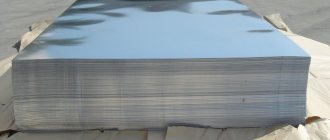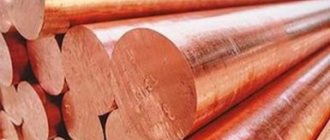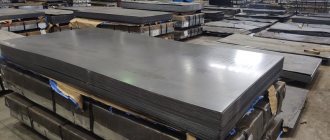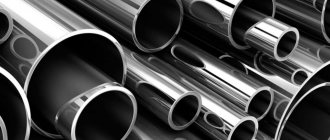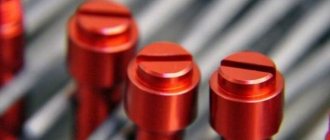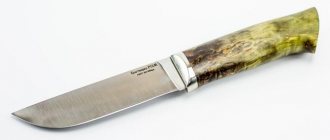Marking, which is used to designate various types of stainless steels, allows you to obtain information not only about the chemical composition of the alloy, but also about the basic properties that it possesses. The rules for the formation of a designation consisting of alphabetic and digital characters are regulated by the provisions of both domestic and international regulatory documents.
Thin-walled stainless steel pipe 12Х18Н10Т
Rules for marking steel alloys in different countries of the world
Steel of various grades, which is widely represented on the modern market, is produced in many countries around the world. In this regard, the issue of adopting international rules by which it is designated is relevant. However, unfortunately, there are no uniform rules for the designation of steels to this day, which often causes serious difficulties both in the sale of such alloys on the international market and in their use in industry.
Some countries (we are talking primarily about the largest steel producers) have adopted their own regulatory documents according to which marking is carried out. For a consumer from another region to choose the right steel, it is necessary to compare its markings with the designations adopted in his country.
European steel marking scheme
In European countries, steel is produced and designated according to the provisions of the EN 100 27 standard, which consists of two parts. The first of these parts stipulates the principle by which steel alloys are assigned certain names, and the second - the principle of assigning numerical designations to steel.
An example of decoding a European steel grade
In Russia, as in many CIS countries, the principle of steel marking is used, borrowed from the old Soviet GOSTs. In accordance with this principle, steel markings are formed from alphabetic and numeric symbols. The numbers indicate the content of certain chemical elements in the alloy, and the letters are the coded names of these elements, as well as the methods by which steel was smelted.
In the USA, which is the largest steel producer, several steel designation systems are used - SAE, AJS, AMS, ASTM, ANSI, ASME, AWS and ACJ. The most common of them, due to greater unification, is ANSI.
Designation of steels in the AISI system
A fairly complex stainless steel marking system is used in Japan. So, in accordance with this system, all steel alloys are divided into separate groups, each of which is designated by a specific letter. Within each of these groups, steels are divided into subgroups, marked with numbers, from which one can determine the chemical composition of the alloy, as well as obtain information about its properties.
Naturally, all of the above systems are used for marking both ordinary and stainless steels.
Compliance of stainless steels with various standards
Application of stainless steel sheets with different types of surface
The surface type of stainless steel sheet is selected depending on the purpose and operating conditions. Mirror stainless steel is in particular demand in the production of tableware, medical equipment, wall panels, and reflectors. Polished matte stainless steel is in demand in construction. Also, sheets with a matte surface (for example, 2B) are used for the production of chemical and pharmaceutical equipment, in pulp and paper mills, in cooling and freezing systems, and sewage systems. Textured and colored sheets are often used for decoration.
Principles of designation of stainless steels in Russia and CIS countries
Stainless steels in Russia and the CIS countries, as mentioned above, are marked using a combination of alphabetic and digital symbols. In this case, the former indicate what chemical elements are contained in the steel, as well as the methods of its smelting, and from the numbers one can determine the quantitative content of the elements listed in the designation of stainless steel.
All letter designations of chemical elements used in marking stainless steels are unified and can be used to unambiguously determine the composition of stainless steel.
Thus, the standard, the basis of which was the Soviet GOST, stipulates the following letter designations of chemical elements:
- C – silicon, which is introduced into the composition of stainless steel so that a layer of scale does not form on the surface of products made from it after heat treatment;
- Yu - aluminum, with the help of which they achieve stabilization of the structure of stainless steel, and also reduce the risk of the formation of foreign inclusions in the structure of the alloy, which can occur at the moment when products made from it come into contact with boiling liquids;
- X – chromium, which is the main alloying element of all stainless steel alloys and gives them exceptional corrosion resistance, for which they are valued;
- M – molybdenum, which imparts stability to the structure of stainless steels during their interaction with aggressive gas environments;
- E – selenium, which provides stainless steel products with the required electrical resistance parameters;
- P – boron, which increases the corrosion resistance of steels when exposed to chemical environments and high temperatures;
- K – cobalt, used to stabilize the carbon contained in steel;
- P – phosphorus, used in steel as a corrosion passivator;
- B – niobium, which is introduced into the composition of stainless steel in order to activate ferritic processes occurring in the crystals of the internal structure of the metal;
- F – vanadium, added to stainless steel to increase its ductility.
Additional letters in the marking of high-quality steels
Naturally, this is not the entire list of chemical elements that may be contained in stainless steel. Like any other steel, a stainless alloy necessarily contains carbon (the letter “U” in the marking), which not only gives it the required strength characteristics, but also increases its resistance to oxidative processes. To give stainless steel good malleability and increase its resistance to high temperatures, nickel is added to it, which is designated by the letter “N” in the alloy markings.
Despite the fact that stainless steels are already highly corrosion resistant, the degree of such protection can be increased by adding copper to their composition, designated in the marking by the letter “D”. In addition to the listed elements, stainless steels may contain manganese (letter “G”), titanium (“T”), zirconium (“C”) and tungsten (“B”).
Main grades of steel and their use in industry
Different grades of stainless steel and their characteristics are designed to work in different environments and conditions, let's consider the most popular and in demand:
- 12Х13, 08Х13, 20х13 for the manufacture of dishes and cutlery, elements and structures with shock loads. Resistant to aggressive environments at normal temperatures. With heat treatment and (or) polishing, the anti-corrosion properties and characteristics are improved.
- 12Х17, 08Х18Т1 is a marking of food grade stainless steel for household kitchen utensils, as well as for equipment for food industry enterprises. It is rational to use products after annealing.
- 30Х13, 40Х13 grade of medical stainless steel from which surgical instruments are made
- 40Х9С2 grade of heat-resistant stainless steel intended for the manufacture of valves for exhaust manifolds of internal combustion engines, diesel engines, heat exchangers.
- 15Х25Т stainless heat-resistant steel is used in high-temperature pyrolysis equipment.
- 12Х18Н9Т for the manufacture of pipes and furnace fittings, spark plug housings
- 40Х9С2 heat-resistant stainless steel, grade intended for engine valves
- 14Х17Н2 equipment operating in environments up to 800 degrees Celsius
- 10Х23Н18 products operating under reduced load conditions and temperatures below 1000 degrees Celsius
Rules for marking corrosion-resistant steels
The designation consists of numbers and letters. The two-digit number at the beginning of the marking is the amount of carbon in hundredths of a percent. The following are letters characterizing certain alloying elements. After them are placed numbers equal to the percentage of alloying elements, rounded to the nearest whole number. If the percentage of the additive is in the range of 1-1.5, then the number is not placed after the letter. To symbolize alloying components in Russian regulatory documentation, the Russian alphabet is used:
- X – chromium;
- N – nickel;
- T – titanium;
- B – tungsten;
- G – manganese;
- D – copper;
- M – molybdenum.
Groups of corrosion-resistant steels by structure
The structure of corrosion-resistant steels, their properties and areas of application are determined by the percentage of carbon, the list and amount of alloying additives. Based on its structure, stainless steel is divided into several types. Main: ferritic, martensitic, austenitic. There are intermediate options.
This group refers to low-carbon alloys - C up to 0.15%. Chromium content – up to 30%. The bulk crystalline structure provides a combination of fairly high strength and ductility. Stainless steels of ferritic grades are classified as ferromagnetic.
- ability to cold deformation;
- the main type of heat treatment is annealing, which removes hardening;
- good corrosion resistance;
- relatively low cost.
The main reason for the loss of performance characteristics of ferritic steels is intergranular corrosion (ICC), as a result of which destruction occurs along grain boundaries. To eliminate this negative phenomenon, sharp cooling of the metal from +800°C is avoided, stabilizing annealing is carried out, and an optimal balance is found between the carbon and chromium content. The introduction of carbide-forming elements—titanium and niobium—can completely eliminate the tendency to MCC.
According to the AISI standard, ferritic steels belong to the 400 series:
- 403-420 – chromium content 11-14%, no nickel;
- 430 and 440 – 15-18% C, no nickel;
- 630 – contains 3-5% nickel. It is well processed, resistant to corrosion in various environments, similar in properties to 08Х18Н10.
These materials are used in the production of a wide range of pipes, sheets, and profiles.
Table of grades of ferritic stainless steel according to GOST and AISI, main areas of use
| Brand according to GOST 5632 | AISI brand | Areas of use |
| 08Х13 | 409 | Cutlery |
| 12Х13 | 410 | Containers for liquid alcohol-containing products |
| 12Х17 | 430 | Containers for high-temperature processing of food products |
Martensitic
This group includes metals with a chromium content of up to 17%, carbon - up to 0.5% (in some cases - higher). Martensite is a structure obtained by hardening a workpiece and then tempering it. It is characterized by a combination of high hardness, strength, elasticity and corrosion resistance. Alloys are used in the production of critical metal products intended for use in aggressive environments. These are springs, shafts, knives, flanges. As the C content increases, a carbide phase appears in the structure, providing high hardness and wear resistance. Carrying out low tempering after hardening (+200...+300°C) provides high hardness - 50-52 HRC, high tempering (+500...+600°C) - lower hardness (28-30HRC) and higher viscosity. Hardening is carried out at temperatures of +950…+1050°C.
Table of martensitic steel grades according to GOST and AISI, their main areas of application
| Brand according to GOST 5632 | AISI brand | Areas of use |
| 20Х13 | 420 | Kitchen equipment |
| 30Х13 | ||
| 40Х13 | ||
| 14Х17Н2 (martensitic-ferritic) | 431 | Compressor unit parts, equipment operated in aggressive environments and at low temperatures |
AISI stainless steel marking
AISI marking is increasingly appearing not only on steel products from overseas, but also on Chinese, Russian, European and other products. This classification system takes its name from its birthplace, the American Iron and Steel Institute. The classifier was liked by consumers, manufacturers, and traders.
The grade of carbon and alloy steel is presented as a four-digit expression. The first digit in it indicates the main alloying component. The second digit identifies the secondary alloying element. The third from fourth digits indicate the carbon content.
- 1ZZZ–C
- 2ZZZ –Ni
- 3ZZZ –Cr+Ni
- 4ZZZ –Mo
- 5ZZZ–Cr
- 6ZZZ - Cr+V
- 7ZZZ –W
- 8ZZZ –Ni+Cr+Mo
- 9ZZZ –Si+Mn
The letter L at the end of the marking indicates reduced carbon content. The same letter in the middle of the marking indicates alloying of the alloy with lead to improve the mechanical properties of steel processed on machines. N at the end of the marking means nitrogen treatment to increase tensile strength, all other things being equal. The letter B in the middle of the marking is boron doping.
Modern industry identifies at least 150 brands by AISI. Let's look at the key, popular steel grades and where they are used.
300 series (family of chromium-nickel alloys)
- 301 - suitable for products with high ductility, characterized by rapid hardening under mechanical influence. Wear-resistant, increased fatigue strength
- 304 is the most widely used grade, which has found application in almost all industries
- 310 – heat-resistant, with the ability to work in aggressive environments at high temperatures (1000 degrees Celsius in oxidative, up to 10,000 in reducing). 310S is suitable for furnace elements in contact with high temperature gases and condensate
- 316 is a steel that holds second place after 304 in terms of application. A favorite brand for the production of equipment for food processing, for surgical instruments, units, modules operating in salt water. Resistance to pitting corrosion
- 321 - for the needs of chemists, the oil industry, welding equipment requiring use at temperatures up to 800 degrees
Decoding of marking according to the European system
The EN system uses only numbers with a dot separator. The first digit determines the material group, where 0 is cast iron, 1 is steel, 2 is heat-resistant alloys, 3 is non-ferrous metals and alloys. The two digits after the dot indicate the steel group, and the subsequent numbers indicate the steel number in the group.
The Metallobaza No. 2 company has a wide range of stainless steel products, which allows you to buy stainless steel that meets international quality standards.
Source: nerzhaveyka-spb.ru

